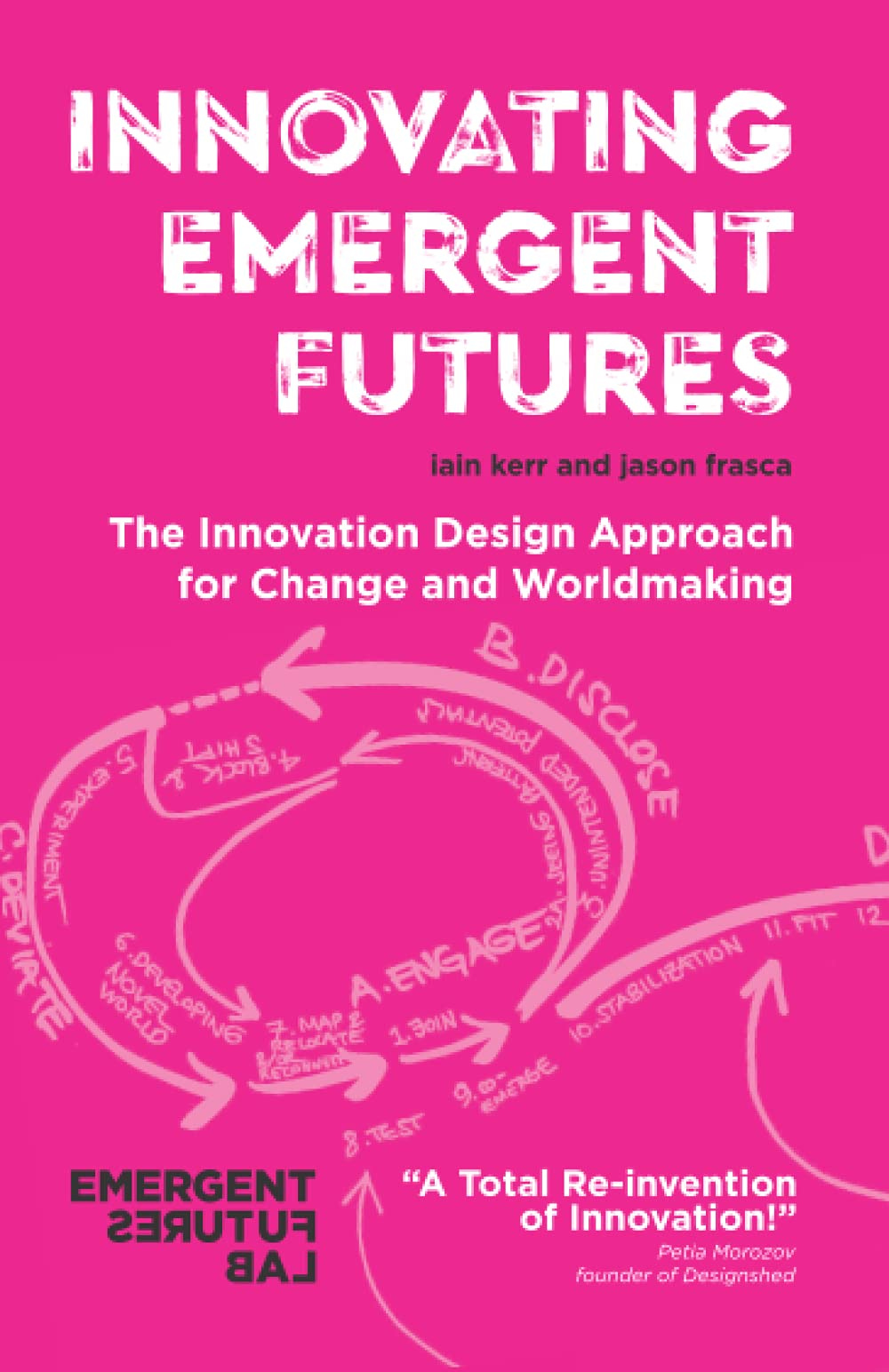4. Why ‘solution’ in Solutions Focus doesn’t mean what you think it means
It's not what you do, it's direction, process and emergence which come from facing the right way
I have been reading a very interesting new book: Innovating Emergent Futures by Iain Kerr and Jason Frasca. This New Jersey-based pair set out to ‘disrupt innovation’ (they say), bypassing the usual post-it notes and idea generation methods towards novel worldmaking, moving from just-another-same-old-same-old to unimagined futures.

It’s good. I particularly like how they really get extended and enactive cognition as a much better match for how the world actually works (as opposed to the misleading mind-stuck-in-the-head framework). They take emergence very seriously and spend quite a bit of time on affordances, the ways that things offer us to engage. “What can it do?” is a much more interesting question than “what is it?”. (I talk about how Solution Focused methods ’stretch the world’ by offering new or newly-relevant affordances in The Next Generation Of Solution Focused Practice.)
They talk a lot about ‘change in kind’ and ‘change in degree’, which I think may not be quite as easy to separate as they think. And I wondered whether the book would be better with more examples. (Maybe they were in the same quandry as me when writing The Solutions Focus in worrying that examples might be taken as ‘the way to do it’ rather than vignettes of a process in action?) Anyway, you can find out more at https://emergentfutureslab.com/, where you can also subscribe to their really first-rate weekly newsletters which are packed with their work in more easily digested chunks.
One thing caught my eye early on in the book. They say (repeatedly)
“Don’t focus on solutions.”
Now, as the author of a best-selling book called The Solutions Focus, you might expect me to be appalled at this advice. After all, Solutions Focus is about focusing on solutions, isn’t it? Isn’t it? Well, no, not really.
What is a ‘solution’?
The dictionary from Oxford Languages on Google says
a means of solving a problem or dealing with a difficult situation.
So it’s something like ‘the answer’ to a problem. When someone says ‘don’t bring me problems, bring me solutions’, they are asking not to be burdened by hard questions but instead furnished with options and answers. When someone says ‘what’s the solution to problem X’ they want something to do which will solve the problem, make it go away, usually in one step.
These are understandable desires. However, in the world of tough complex interlinked and emergent issues, such simplistic answers are usually not possible. Any actual action will have knock-on effects, only some of which were intended. The kinds of problem which have solutions are highly bounded and defined. The chess column’s puzzle to ‘find checkmate in three moves’ is a good example – there is a solution, and it’s logically complete and solid. (If the rules of chess emerged and changed every move in uncertain ways, that would be a very different and more difficult challenge.)
Let’s go back to Iain Kerr and Jason Frasca’s book. They write:
Do not focus on solutions (this will only lead you away from innovation). If you already know where you want to end up — then there will be no innovation. Focus on the process. Let the solution reveal itself to you through the process.
I agree 100%. Let’s look at this statement through the lens of solution focused practice.
What is Solution Focus?
Solution Focus as I have written about it came from Solution Focused Brief Therapy (SFBT), a member of the interactional brief therapy tradition which emerged in the mid-late 1980s at the Brief Family Therapy Centre, Milwaukee under the guidance of Steve De Shazer and Insoo Kim Berg. This tradition started as an offshoot of the family therapy movement of the Mental Research Institute (MRI), Palo Alto, whose work was greatly informed by their involvement with Gregory Bateson.

This tradition questioned the traditional view (espoused by Freud, Jung and others) that mental illness was the result of some kind of hidden disorder, repressed emotions, traumatic childhood experience or whatever which had to be resolved or at least ‘worked through’ before any positive change could be expected. Instead of accepting this view where change could not be expected for months or even years, the MRI group explored a different route where mental illness was construed instead as dysfunctional patterns of behaviour and communication. By this view, there was assumed to be a change which, if carried out today, would at least disturb the existing problem patterns and reveal more about how to move things forward.
This brief therapy approach was effective and also capable of refinement. The BFTC group in Milwaukee explored how to make it even briefer and remove extraneous elements. They found that things moved even more swiftly if rather than establishing problem patterns to be disturbed, practitioners sought to identify and reinforce ‘solution’ patterns – things that were already working for their clients but were overlooked by the focus on the problem. A later development was a focus on what clients wanted in their day to day lives, in terms of everyday mundane detail. This kind of practice, which I first came across in 1993, has the great benefit of not needing any kind of problem-statement; if people are persistently bugged by something they hope to happen but doesn’t (or indeed they hope not to happen but does), then we can work with it.
SFBT does not aim for a ‘solution’ in the usual sense. It aims to help people clarify what they want in their lives (often in great detail) and also look at what is working to help them move in this direction, with the aim of them taking often very small steps which start to help. There is no sense in which a session of SFBT is intended to make the problem go away immediately (though that does happen occasionally) – it’s more like helping the client feel that their hopes are reasonable and that they have agency in moving themselves along towards those hopes. Then they can carry on the normal exigencies of tackling their life rather than being stuck.
Emergence in action
This is emergence in action. The (actual) end point is uncertain, the route unclear… but the process is intended to help the clients feel more like they have agency and that they can and are moving themselves along. That’s mental health. Mental illness, on the other hand, usually looks like ‘I hate this life’ and ‘I can’t do anything about it’.
Moving SFBT methods and practices out of the therapy room and into other settings (including coaching and organisational change) was what Paul Z Jackson and I wanted to do in writing The Solutions Focus book in 2002. This was the first book (in English, at least) to describe the use of SF methods in other settings. We wanted to make clear the important connection with SFBT in choosing the title (and also keep the publisher happy!). Looking back, I fear that many people may have glanced at the title, assumed they knew what it meant, and moved on. It doesn’t resonate well with those who, like Kerr and Frasca, are looking for something subtle, emergent and yet also incisive in cutting through a great deal of nonsense (away from causation, blame, plans, heroic metaphors and inflicted misery) through giving a robust, simple-yet-not-easy framework for emerging progress one sentence at a time.

Direction is key
There is a useful distinction to be drawn (and Kerr & Frasca draw it) between ‘knowing where you want to end up’ (which is inviting a planned process towards something known) and establishing a direction for progress. Without some kind of direction for ‘better’, it’s very hard to make judgements about how useful something is. A lot of SF process goes into establishing the direction of better; the platform/best hopes and future perfect/preferred future conversations are all about this, and even scales can help (“where 10 on the scale is your best hopes are realised…”).
One of the key insights of SF and its SFBT forebears is that the direction of better is not simply 180 degrees around from the direction of worse. That is the assumption of problem solving; if the problem is removed then we are automatically as good as it can be. In SF the directions of better and worse are not simply opposites, they are completely independent. So, knowing the direction of worse tells you pretty much nothing about the direction of better; this has to be established, in a provisional way at least, by the person concerned rather than assumed. That’s why started with something like ‘what are your best hopes from our work?’ is such a key building block, very different from ‘what’s wrong?’ or ‘what do you want to talk about?’.
It turns out the direction is also key in the world of equestrianism. My long time good friend and accelerated learning colleague Paul Scheele has confronted his lifelong fear of horses by taking a short session with an equine therapist. He writes entertainingly about it in his latest newsletter. It turns out that where you’re looking is where the horse will head towards. If you look at the ground in front of you, no go. If you look at the other side of the field and give the horse a kick, we’re off.
“To oppose something is to maintain it”
I’ll finish this week with a quote from speculative fiction author Ursula Le Guin. Her 1969 book The Left Hand Of Darkness, a landmark in feminist science fiction and exploring gender in alternative ways, features a county with the city of Mishnory as its capital. One character says:
“To oppose something is to maintain it. They say here "all roads lead to Mishnory." To be sure, if you turn your back on Mishnory and walk away from it, you are still on the Mishnory road. To oppose vulgarity is inevitably to be vulgar. You must go somewhere else; you must have another goal; then you walk in a different road.”
One message from this startling speech is about the importance of not simply being anti-problem. Being pro-something else is much more valuable. What’s the direction of your ‘better’?
News and dates
I am participating in a free call run by SF24, the annual 24 hour online jamboree of Solution Focused practitioners this Thursday 2 February 2023 at 4pm UK time. We are discussing my ‘three levels of description building’ model with a 10 minute video, discussion and Q&A. Free to join, register at https://www.eventbrite.co.uk/e/sf24-watch-parties-tickets-192759768657.
I am hosting the third Bushe Marshak Institute Authors Salon on Tuesday 7 February 2023, again online at 4pm UK time for 90 minutes. Our topic is Dialogue and Action – what’s the connection between them? More details and free registration at https://www.eventbrite.co.uk/e/bmi-dialogic-od-salon-3-dialogue-and-action-tickets-483728183017. It’s very close to sold out so get in while you can.






Thank you for another nice and inspiring text! it is really nice to read them several times! thanks for the reminder that SF is such a successful way to approach wicked problems. I guess that's why I think that it has worked so well to use also in the borderland between psychiatry and social work, for example with families, addiction treatment, social psychiatry and crimeprevention. the complex has a place in SF.
And in workplaces and in work groups SF contributes to both psychological safety and social safety, I think.